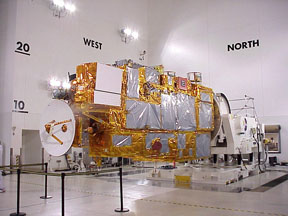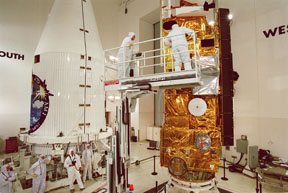Approximately the size of a small school bus, the Terra satellite carries five instruments that take coincident measurements of the Earth system:
- Advanced Spaceborne Thermal Emission and Reflection Radiometer (ASTER)
- Clouds and Earth’s Radiant Energy System (CERES)
- Multi-angle Imaging Spectroradiometer (MISR)
- Measurements of Pollution in the Troposphere (MOPITT)
- Moderate Resolution Imaging Spectroradiometer (MODIS)
Terra is in a circular sun-synchronous polar orbit that takes it from north to south (on the daylight side of the Earth) every 99 minutes.

Spacecraft Quick Facts:
- Launch Date: December 18,1999
- Size: the spacecraft bus is 6.8 m long and 3.5 m across.
- Weight: 5,190 kg (11,442 lbs.) at launch.

Orbit Quick Facts:
- Altitude: 705 kilometers (438 miles) above Earth’s surface
- Inclination: 98.5 degrees
- Period: 99 minutes (14 complete orbits per day)
- Ground track repeat: 16 days
- Equatorial crossing: 10:30 a.m., descending mode
Terra Status:
- Operating instruments: ASTER, CERES, MODIS, MISR, and MOPITT are operating well. ASTER Short Wave Infrared (SWIR) data is unavailable.
- Current systems issues: None.
- Processed Terra data are available through several NASA data centers.
- Current life expectancy: Terra has far exceeded its design life and has a strong chance of operating successfully into the early 2020s. Terra began drifting in February of 2020. Read more about Terra’s drifting or see key dates below.
Key dates of Drift
- Exceed 10:30 MLT (+/- 1 min) – April 2021*
- Exceed 10:15 MLT – October 2022*
- Constellation Exit – October 2022*
- Exceed 9:00 MLT – December 2025*
Passivation dates are not yet determined, but passivation is expected to take place due to signal to noise limits from lower solar zenith angles, limited battery power from changing solar angle on the solar panels, or programmatic funding limits.
*Dates are subject to change.

